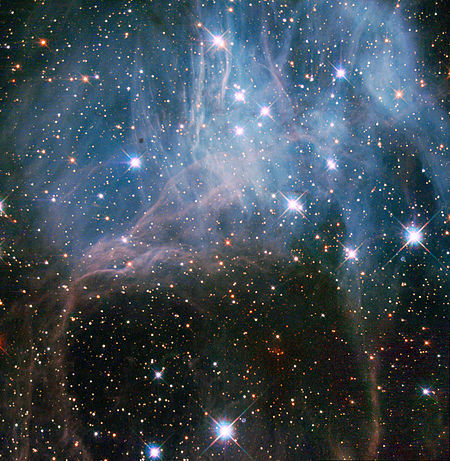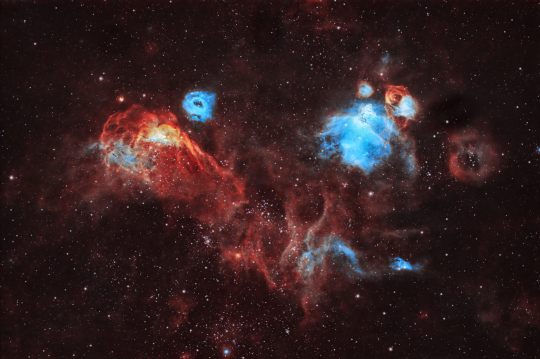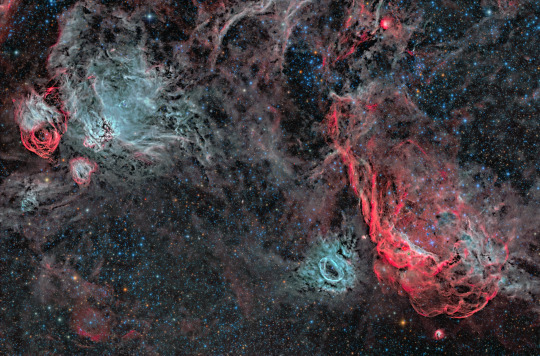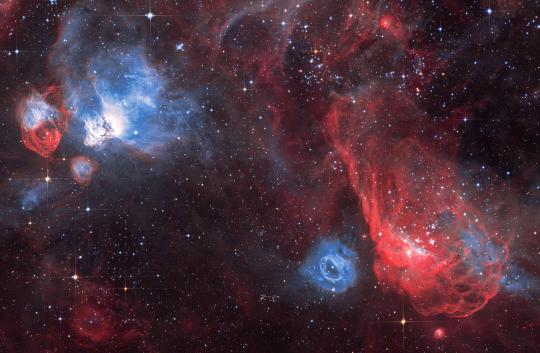#NGC 2040
Explore tagged Tumblr posts
Text

A Fiery Rose Captured by Gemini South
The NGC 2040 star cluster fuels the growth of this cosmic flower as the stellar life cycle unfolds within it
Displaying wispy layers of red, orange and yellow, the nebula encasing NGC 2040 resembles a vibrant rose in this image captured by the Gemini South telescope, one half of the International Gemini Observatory, which is supported in part by the U.S. National Science Foundation and operated by NSF NOIRLab. This nebulous flower showcases the dramatic story of stellar life, death and rebirth.
NGC 2040 is a young open cluster of stars within the Large Magellanic Cloud, a satellite galaxy of the Milky Way, located about 160,000 light-years from Earth. It is a type of star cluster known as an OB association because it contains more than a dozen stars of the O and B spectral types. These stars lead short lives of only a few million years, during which they burn very hot before exploding as supernovae. The energy released by the explosions of these massive stars feeds the formation of NGC 2040’s structure, while the expelled material seeds the growth of the next generation of stars.
The veiled nebula’s delicate structure, resembling a Valentine’s Day rose, is revealed in this image captured with the Gemini South telescope, one half of the International Gemini Observatory, funded in part by the U.S. National Science Foundation and operated by NSF NOIRLab. The 8-meter optical/infrared telescope is perfectly suited to capturing both the bright stars and the diffuse glow of the cluster.
NGC 2040 contains mostly hydrogen and oxygen atoms. As these atoms are excited by the ultraviolet radiation from nearby massive stars, they emit light. This emitted light spans a range of wavelengths from the ultraviolet, through the visible, and into the infrared. Special filters on Gemini South then allow specific wavelengths, or colors, of this emitted light to pass through, like the deep red and orange of glowing hydrogen and the light blue of glowing oxygen. The bright white represents areas where there is an abundance of both.
NGC 2040 is so named because it is part of the New General Catalogue of deep sky objects, first compiled by John Dryer in 1888. More recent observations have revealed that it is part of a massive structure of interstellar gas known as LH 88, which is one of the largest active star-forming regions in the Large Magellanic Cloud. Over the next million years thousands of new stars will be born in the region.
Most of the stars in the Milky Way, including the Sun, likely formed within open clusters similar to NGC 2040. When the O and B stars end their lives as supernovae they will enrich the cluster with elements such as carbon, oxygen, and iron. Together with the bountiful hydrogen of the cluster, these elements provide the necessary ingredients for the formation of new stars, planets, and perhaps even life.
The bright stars seen in the image are widely separated, but their motions through space are similar, indicating that they have a common origin. The layered nebulous structures in LH 88 are the remnants of stars that have already died. The delicate leaves of the rose were formed by both the shockwaves from supernovae and the stellar winds of the O and B stars.
Taken as a whole, the rose of LH 88 tells a story of death and rebirth, where the dust of dead stars becomes the seeds of new stars and planetary systems. And like a rose the beauty of LH 88 is fleeting. Within a few million years — a brief moment of cosmic time — the gas and dust will be either gathered into young stars or cast off into interstellar space. The stars formed within the cluster will have moved on to their own journeys through their galaxy.
IMAGE: Displaying wispy layers of red, orange and yellow, the nebula encasing NGC 2040 resembles a vibrant rose in this image captured by the Gemini South telescope, one half of the International Gemini Observatory, which is supported in part by the U.S. National Science Foundation and operated by NSF NOIRLab. This nebulous flower showcases the dramatic story of stellar life, death and rebirth. Credit: International Gemini Observatory/NOIRLab/NSF/AURA Image Processing: J. Miller & M. Rodriguez (International Gemini Observatory/NSF NOIRLab), T.A. Rector (University of Alaska Anchorage/NSF NOIRLab), M. Zamani (NSF NOIRLab)
youtube
Displaying wispy layers of red, orange and yellow, the nebula encasing NGC 2040 resembles a vibrant rose in this image captured by the Gemini South telescope, one half of the International Gemini Observatory, which is supported in part by the U.S. National Science Foundation and operated by NSF NOIRLab. This nebulous flower showcases the dramatic story of stellar life, death and rebirth.Credit:
Images and Videos: International Gemini Observatory/NOIRLab/NSF/AURA/T. Matsopoulos/N. Bartmann (NSF NOIRLab)
Image Processing: J. Miller & M. Rodriguez (International Gemini Observatory/NSF NOIRLab), T.A. Rector (University of Alaska Anchorage/NSF NOIRLab), M. Zamani (NSF NOIRLab)
Music: Produced by Konstantino Polizois
youtube
Displaying wispy layers of red, orange and yellow, the nebula encasing NGC 2040 resembles a vibrant rose in this image captured by the Gemini South telescope, one half of the International Gemini Observatory, which is supported in part by the U.S. National Science Foundation and operated by NSF NOIRLab. This nebulous flower showcases the dramatic story of stellar life, death and rebirth.Credit:
Images and Videos: International Gemini Observatory/NOIRLab/NSF/AURA/T. Matsopoulos/N. Bartmann (NSF NOIRLab)
Image Processing: J. Miller & M. Rodriguez (International Gemini Observatory/NSF NOIRLab), T.A. Rector (University of Alaska Anchorage/NSF NOIRLab), M. Zamani (NSF NOIRLab)
Music: Stellardrone - Light Years
youtube
Displaying wispy layers of red, orange and yellow, the nebula encasing NGC 2040 resembles a vibrant rose in this image captured by the Gemini South telescope, one half of the International Gemini Observatory, which is supported in part by the U.S. National Science Foundation and operated by NSF NOIRLab. This nebulous flower showcases the dramatic story of stellar life, death and rebirth.Credit:
International Gemini Observatory/NOIRLab/NSF/AURA/ESO/VMC Survey/N. Bartmann (NSF NOIRLab)
Image Processing: J. Miller & M. Rodriguez (International Gemini Observatory/NSF NOIRLab), T.A. Rector (University of Alaska Anchorage/NSF NOIRLab), M. Zamani (NSF NOIRLab)
Music: zero project - Through the Looking Glass
0 notes
Photo

Stars in the cosmic haze: NGC 2040 © Hubble
#hubble telescope#space#stars#star cluster#night sky#astrophotography#galaxy#planet#nebula#planets#universe#astronomy#nasa#cosmos
2K notes
·
View notes
Photo

NGC 2040 in the Large Magellanic Cloud by NASA Hubble
693 notes
·
View notes
Text

The stellar grouping is known to stargazers as NGC 2040 or LH 88. It is essentially a very loose star cluster whose stars have a common origin and are drifting together through space. There are three different types of stellar associations defined by their stellar properties. NGC 2040 is an OB association, a grouping that usually contains 10–100 stars of type O and B — these are high-mass stars that have short but brilliant lives. It is thought that most of the stars in the Milky Way were born in OB association
Credit: ESA/Hubble, NASA and D. A Gouliermis. Acknowledgement: Flickr user Eedresha Sturdivant
887 notes
·
View notes
Photo

NGC 2020, NGC 2040, NGC 1935, NGC 1934 and NGC 1955 in the Large Magellanic Cloud. Taken from Clayton Bay, Australia. [2500 x 1869] (Credit: Paul Haese) via /r/spaceporn. Picture posted by /u/hominoid_in_NGC4594.
4 notes
·
View notes
Photo

NGC 2040, uma das maiores áreas de formação de estrelas na Grande Nuvem de Magalhães a cerca de 150 mil anos-luz de distância da Terra. by @esoastronomy https://www.instagram.com/p/CKUS6goJR1J/?igshid=dtfun8gitey6
0 notes
Photo

Hubble peeks inside a stellar cloud
These bright stars shining through what looks like a haze in the night sky are part of a young stellar grouping in one of the largest known star formation regions of the Large Magellanic Cloud (LMC), a dwarf satellite galaxy of the Milky Way. The image was captured by the NASA/ESA Hubble Space Telescope’s Wide Field Planetary Camera 2.
The stellar grouping is known to stargazers as NGC 2040 or LH 88. It is essentially a very loose star cluster whose stars have a common origin and are drifting together through space. There are three different types of stellar associations defined by their stellar properties. NGC 2040 is an OB association, a grouping that usually contains 10–100 stars of type O and B — these are high-mass stars that have short but brilliant lives. It is thought that most of the stars in the Milky Way were born in OB associations.
There are several such groupings of stars in the LMC, including one previously featured as a Hubble Picture of the Week. Just like the others, LH 88 consists of several high-mass young stars in a large nebula of partially ionised hydrogen gas, and lies in what is known to be a supergiant shell of gas called LMC 4.
Over a period of several million years, thousands of stars may form in these supergiant shells, which are the largest interstellar structures in galaxies. The shells themselves are believed to have been created by strong stellar winds and clustered supernova explosions of massive stars that blow away surrounding dust and gas, and in turn trigger further episodes of star formation.
The LMC is the third closest galaxy to our Milky Way. It is located some 160 000 light-years away, and is about 100 times smaller than our own.
This image, which shows ultraviolet, visible and infrared light, covers a field of view of approximately 1.8 by 1.8 arcminutes.
A version of this image was entered into the Hubble’s Hidden Treasures Image Processing Competition by contestant Eedresha Sturdivant. Hidden Treasures is an initiative to invite astronomy enthusiasts to search the Hubble archive for stunning images that have never been seen by the general public.
These bright stars shining through what looks like a haze in the night sky are part of a young stellar grouping in one of the largest known star formation regions of the Large Magellanic Cloud (LMC), a dwarf satellite galaxy of the Milky Way. The image was captured by the NASA/ESA Hubble Space Telescope’s Wide Field Planetary Camera 2.
The stellar grouping is known to stargazers as NGC 2040 or LH 88. It is essentially a very loose star cluster whose stars have a common origin and are drifting together through space. There are three different types of stellar associations defined by their stellar properties. NGC 2040 is an OB association, a grouping that usually contains 10–100 stars of type O and B — these are high-mass stars that have short but brilliant lives. It is thought that most of the stars in the Milky Way were born in OB associations.
There are several such groupings of stars in the LMC, including one previously featured as a Hubble Picture of the Week. Just like the others, LH 88 consists of several high-mass young stars in a large nebula of partially ionised hydrogen gas, and lies in what is known to be a supergiant shell of gas called LMC 4.
Over a period of several million years, thousands of stars may form in these supergiant shells, which are the largest interstellar structures in galaxies. The shells themselves are believed to have been created by strong stellar winds and clustered supernova explosions of massive stars that blow away surrounding dust and gas, and in turn trigger further episodes of star formation.
The LMC is the third closest galaxy to our Milky Way. It is located some 160 000 light-years away, and is about 100 times smaller than our own.
This image, which shows ultraviolet, visible and infrared light, covers a field of view of approximately 1.8 by 1.8 arcminutes.
A version of this image was entered into the Hubble’s Hidden Treasures Image Processing Competition by contestant Eedresha Sturdivant. Hidden Treasures is an initiative to invite astronomy enthusiasts to search the Hubble archive for stunning images that have never been seen by the general public.
ESA/Hubble, NASA and D. A Gouliermis. Acknowledgement: Flickr user Eedresha Sturdivant
https://www.spacetelescope.org/images/potw
#space#astronomy#space images#space pictures#astrophotography#space--bot#Id#potw1216a#Type#Observation#Release#date#16#April#2012#1000#Size#1075#1100#Name#NGC#2040#Local#Universe#Star#Grouping#Cluster#Distance#150000
13 notes
·
View notes
Photo

Loose Star Cluster
280 notes
·
View notes
Text

Nebulosity in the LMC // gregengland
#astronomy#astrophotography#nebula#emission nebula#star-forming region#LMC#large magellanic cloud#NGC 1934#IC 2128#NGC 1937#NGC 1955#NGC 1968#NGC 2002#NGC 2004#NGC 2014#NGC 2020#NGC 2027#NGC 2030#NGC 2032#NGC 2034#NGC 2035#NGC 2040#NGC 2041#dorado
57 notes
·
View notes
Text

The Cosmic Reef in the LMC // Richard Bamfield
Included in this image are the nebulae (from left to right): NGC 2014 (red), NGC 2020 (blue), NGC 2030+NGC 2032+NGC 2035 (blue), and NGC 2040 (blue and red).
#astronomy#astrophotography#nebula#emission nebula#star-forming region#NGC 2020#NGC 2014#NGC 2030#NGC 2035#NGC 2032#NGC 2040#LMC#large magellanic cloud#dorado
77 notes
·
View notes
Text

The "Cosmic Reef" in the LMC // Alex Woronow
#astronomy#astrophotography#nebula#emission nebula#star-forming region#NGC 2020#NGC 2014#NGC 2011#NGC 2035#NGC 2032#NGC 2029#NGC 2040#LMC#large magellanic cloud#dorado
54 notes
·
View notes
Text

Several star-forming regions in the LMC // Rocco Sung
Among them are: NGC 2020 (blue, lower right), NGC 2014 (red, lower right), NGC 2040 (red, upper left), and NGC 2030 (blue, upper left).
#astronomy#astrophotography#nebula#emission nebula#star-forming region#NGC 2020#NGC 2014#NGC 2040#NGC 2030#LMC#large magellanic cloud#dorado
66 notes
·
View notes
Photo

The Seagull Nebula (NGC 2032, below center), the Dragon Head’s Nebula (NGC 2035, left center), and NGC 2040 (top right) // Eduardo Rigoldi Fernandes
#astronomy#astrophotography#nebula#emission nebula#star-forming region#seagull nebula#dragon head's nebula#NGC 2032#NGC 2035#NGC 2040#LMC#large magellanic cloud#dorado
202 notes
·
View notes
Photo

The NGC 2020 region in the LMC // ManuelCP
Noted nebulae incluce: NGC 2020 (bottom center, blue), NGC 2014 (bottom right, red), NGC 2032 (left, blue), and NGC 2040 (left, red)
#astronomy#astrophotography#nebula#emission nebula#star-forming region#NGC 2020#NGC 2014#NGC 2032#NGC 2040#LMC#large magellanic cloud#dorado
127 notes
·
View notes
Photo

The Cosmic Reef // jackstar
#astronomy#astrophotography#nebula#emission nebula#star-forming region#NGC 1955#NGC 1968#NGC 1974#NGC 2004#NGC 2011#NGC 2014#NGC 2020#NGC 2021#NGC 2032#NGC 2040#cosmic reef#dorado
67 notes
·
View notes
Photo

NGC 2040 in the Large Magellanic Cloud by NASA Hubble
651 notes
·
View notes